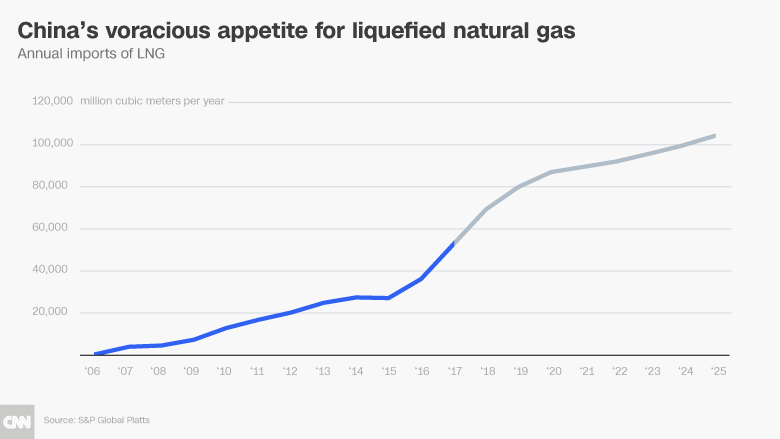The United States has an abundance of natural gas that pollution-riddled China badly needs to wean itself off coal.
Eying China's voracious demand, Cheniere Energy, ExxonMobil (XOM)
and other American energy companies are racing to build more than two
dozen expensive facilities to export liquefied natural gas, which is
super-cooled natural gas that can be transported by ship.
China even marked President Donald Trump's visit to Beijing last fall by agreeing to invest as much as $43 billion into an LNG project in Alaska.
But this pairing of an able buyer and well-supplied seller no longer looks like a slam dunk. As part of the escalating trade war, China on Tuesday said it will impose a 10% tariff on $60 billion of US products -- including LNG. The trade tensions could make it more difficult for the next wave of LNG export facilities to get the financing needed to get off the ground.
"It's obviously very concerning. The potential for some projects to get delayed is very real," said Charlie Riedl, executive director of the Center for Liquefied Natural Gas, a trade group that represents Exxon, Chevron (CVX) and other energy companies.
The shale boom created an excess of natural gas in the United States. In a bid to get rid of the glut, the United States began exporting LNG in 2016 when Houston-based Cheniere (LNG) opened the Sabine Pass terminal in Louisiana. Earlier this year, Dominion Energy (D) opened Cove Point in Maryland, the nation's second export facility .
China is the big elephant in the room. China's appetite for LNG is growing rapidly. And it's on the verge of overtaking Japan as the biggest buyer of LNG in the world.
That's one major reason why the United States is planning to quadruple its export capacity by building at least 25 new facilities. LNG is a centerpiece of Trump's energy dominance agenda.

Tariffs less than feared
Now, the tariffs will likely price US LNG out of the Chinese market, according to S&P Global Platts."There are other suppliers around the world that would gladly supply China -- and they don't have a 10% tariff," said Riedl.
Kyle Isakower, vice president for economic policy at the American Petroleum Institute, said in a statement that the trade situation "works against US energy sector growth and counter to the administration's stated goal of 'energy dominance.'"
The good news is that China had threatened an even bigger tariff -- 25% -- on US LNG. Cheniere's share price rallied 2% on Tuesday in response to the lower-than-feared rate.
In any case, analysts don't believe that overall US LNG exports will be dramatically hurt in the short run. There are plenty of other buyers, including Japan, South Korea, Taiwan and Latin America. And Washington has been pushing Europe to break its addiction to natural gas from Russia.
"If China buys less, someone else will buy more," said Pavel Molchanov, an energy analyst at Raymond James. "It doesn't matter if it's a Chinese buyer, a European buyer or a Latin American buyer. Revenue is revenue."




0 comments:
Post a Comment